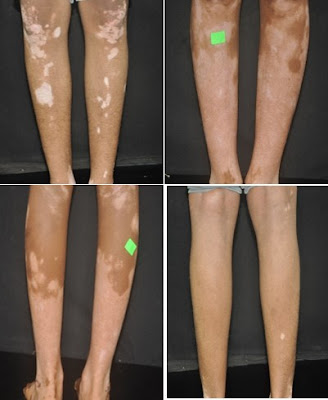Leukoderma or Vitiligo
Vitiligo is a highly stigmatic, skin disorder that occurs
after birth, where the skin colour in some areas of the body becomes white due
to progressive loss of melanocytes, which are responsible for the colour of the
skin. It affects 1-2% of the population and is more obvious in the Indian skin,
whereas in western skin it is not stigmatic. The darker-skinned a person is,
the more their vitiligo stands out, because of the contrast between the
affected and unaffected skin.
Vitiligo occurs due to
the destruction of melanocytes (the aforementioned melanin pigment-producing
cells) due to genetic or autoimmune, where a person's immune system reacts
against the body`s organ or tissue. Various factors control the progression of
this disease, mainly the psychological factor and the diet. Sometimes it is
genetic which runs in families.
The major issue in
Vitiligo is its psychological impact on most of the patients and their families
rather than the disease per se, mainly because of the stigma and misconceptions
attached to this disease. It can lead to embarrassment, a sense of humiliation,
loss of self-esteem, negative effects on marital life sometimes ending in
divorce, and job discrimination leading to impairment in the quality of life.
It can affect a person's emotional and psychological well-being and may create
difficulty in professional and social situations. They express emotional
stress, especially if the vitiligo patches are on the visible areas of the
body, such as the face, hands, arm, leg, and lips. Adolescents who are particularly
concerned about their appearance can be devastated by widespread disease.
Vitiligo has become a marked social stigma in our country where the marriage of
the affected individual is difficult even today. In children, sometimes it
severely affects their self-esteem by getting teased in the school, so much so
that the child gets depressed, refuses to go to school, and even gets suicidal
thoughts!.
Vitiligo is diagnosed by
clinical examination, coupled with a test called wood`s lamp examination.
Sometimes a skin biopsy is necessary to differentiate it from other white
patches. Occasionally, Vitiligo is associated with other autoimmune diseases
like thyroid disease and diabetes Mellitus. So, a blood test is essential to
find out these diseases.
The management of
Vitiligo, even though there is no complete cure, is very crucial. The doctor
should be empathetic and should be a good listener. He/ she should be able to
provide emotional support to the patient and the family. So, counseling becomes
a very important step to overcome the initial storm. There are various modes of
treatment depending upon the age of the patient. Topical therapy, PUVASOL
(exposure to sunlight after 2 hours of taking the tablet), phototherapy,
surgical treatments, and lasers in addition to diet correction. In the case of stable Vitiligo,
split-thickness skin grafting can be of help. This procedure has the advantage
of providing uniform pigmentation over a short period of time. Cosmetic camouflage
is very important to conceal the visible patches. Skin camouflage is a
specially formulated product, which is used to conceal the color or contour
defects of the skin. To camouflage vitiligo, opaque creams in the shades of
brown matching the patient's skin color are being used. If the disease
increases after taking the treatment either in biomedicine or alternative
medicine, we need to find out the causative medicine which is responsible for
it.
There are several
patient support groups for Vitiligo, providing a common platform for patients
to meet and discuss their problems, both online and face to face. Hearing
real-life experiences of other vitiligo patients can itself boost confidence,
which in turn help the treatment response. Many of these groups provide job and
matrimonial opportunities. Patients can log into such groups, e.g., Vitiligo
support international, Vitiligo friends, Shwetha association, and the Vitiligo
Society.





Comments